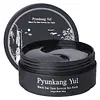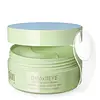What's inside
What's inside
 Key Ingredients
Key Ingredients

 Benefits
Benefits

 Concerns
Concerns

 Ingredients Side-by-side
Ingredients Side-by-side

Water
Skin ConditioningGlycerin
HumectantNiacinamide
SmoothingChondrus Crispus Extract
Skin ConditioningCeratonia Siliqua Gum
EmollientCellulose Gum
Emulsion Stabilising1,2-Hexanediol
Skin ConditioningHydroxyacetophenone
AntioxidantSucrose
HumectantPotassium Chloride
Calcium Aluminum Borosilicate
CI 77499
Cosmetic ColorantSaccharomyces/Xylinum/Black Tea Ferment
Skin ConditioningAllantoin
Skin ConditioningXanthan Gum
EmulsifyingCoptis Chinensis Root Extract
AntioxidantEthylhexylglycerin
Skin ConditioningSilica
AbrasiveAdenosine
Skin ConditioningCI 77891
Cosmetic ColorantBis-PEG-15 Methyl Ether Dimethicone
EmulsifyingDisodium EDTA
Mica
Cosmetic ColorantDipotassium Glycyrrhizate
HumectantGlycine Max Seed Extract
Skin ConditioningBetula Alba Leaf Extract
AstringentPolyglyceryl-6 Caprylate
EmulsifyingPolyglyceryl-4 Caprate
EmulsifyingSodium Polyacryloyldimethyl Taurate
Emulsion StabilisingButylene Glycol
HumectantCamellia Sinensis Leaf Extract
AntimicrobialOryza Sativa Bran Extract
Skin ConditioningPearl Extract
AntioxidantMelaleuca Alternifolia Leaf Extract
PerfumingTin Oxide
AbrasivePropanediol
SolventHydrolyzed Collagen
EmollientCeramide NP
Skin ConditioningGlyceryl Polymethacrylate
Tocopherol
AntioxidantHydrolyzed Glycosaminoglycans
HumectantSodium Hyaluronate
HumectantPropylene Glycol
HumectantSodium Hyaluronate Crosspolymer
HumectantHydrolyzed Hyaluronic Acid
HumectantHydroxypropyltrimonium Hyaluronate
Hyaluronic Acid
HumectantSodium Acetylated Hyaluronate
HumectantPalmitoyl Tripeptide-1
Skin ConditioningWater, Glycerin, Niacinamide, Chondrus Crispus Extract, Ceratonia Siliqua Gum, Cellulose Gum, 1,2-Hexanediol, Hydroxyacetophenone, Sucrose, Potassium Chloride, Calcium Aluminum Borosilicate, CI 77499, Saccharomyces/Xylinum/Black Tea Ferment, Allantoin, Xanthan Gum, Coptis Chinensis Root Extract, Ethylhexylglycerin, Silica, Adenosine, CI 77891, Bis-PEG-15 Methyl Ether Dimethicone, Disodium EDTA, Mica, Dipotassium Glycyrrhizate, Glycine Max Seed Extract, Betula Alba Leaf Extract, Polyglyceryl-6 Caprylate, Polyglyceryl-4 Caprate, Sodium Polyacryloyldimethyl Taurate, Butylene Glycol, Camellia Sinensis Leaf Extract, Oryza Sativa Bran Extract, Pearl Extract, Melaleuca Alternifolia Leaf Extract, Tin Oxide, Propanediol, Hydrolyzed Collagen, Ceramide NP, Glyceryl Polymethacrylate, Tocopherol, Hydrolyzed Glycosaminoglycans, Sodium Hyaluronate, Propylene Glycol, Sodium Hyaluronate Crosspolymer, Hydrolyzed Hyaluronic Acid, Hydroxypropyltrimonium Hyaluronate, Hyaluronic Acid, Sodium Acetylated Hyaluronate, Palmitoyl Tripeptide-1
Water
Skin ConditioningGlycerin
HumectantCalcium Chloride
AstringentXanthan Gum
EmulsifyingCeratonia Siliqua Gum
EmollientNiacinamide
SmoothingButyrospermum Parkii Butter
Skin ConditioningChondrus Crispus Powder
AbrasiveAllantoin
Skin ConditioningArginine
MaskingGold
Cosmetic ColorantCocos Nucifera Fruit Extract
EmollientPinus Sylvestris Leaf Extract
TonicCucumis Sativus Fruit Extract
EmollientRubus Idaeus Fruit Extract
AstringentRubus Coreanus Fruit Extract
Skin ConditioningVaccinium Angustifolium Fruit Extract
Skin ProtectingRibes Nigrum Leaf Extract
PerfumingEuterpe Oleracea Fruit Extract
Camellia Sinensis Leaf Extract
AntimicrobialChamomilla Recutita Flower Extract
MaskingCamellia Japonica Flower Extract
EmollientArnica Montana Flower Extract
MaskingAloe Barbadensis Leaf Extract
EmollientSodium Hyaluronate
HumectantCaffeine
Skin ConditioningDipotassium Glycyrrhizate
Humectant1,2-Hexanediol
Skin ConditioningPentylene Glycol
Skin ConditioningHydroxyacetophenone
AntioxidantPolyglyceryl-10 Laurate
Skin ConditioningEthylhexylglycerin
Skin ConditioningCellulose Gum
Emulsion StabilisingSodium Phytate
Phenoxyethanol
PreservativeSynthetic Fluorphlogopite
CI 77891
Cosmetic ColorantCI 77288
Cosmetic ColorantWater, Glycerin, Calcium Chloride, Xanthan Gum, Ceratonia Siliqua Gum, Niacinamide, Butyrospermum Parkii Butter, Chondrus Crispus Powder, Allantoin, Arginine, Gold, Cocos Nucifera Fruit Extract, Pinus Sylvestris Leaf Extract, Cucumis Sativus Fruit Extract, Rubus Idaeus Fruit Extract, Rubus Coreanus Fruit Extract, Vaccinium Angustifolium Fruit Extract, Ribes Nigrum Leaf Extract, Euterpe Oleracea Fruit Extract, Camellia Sinensis Leaf Extract, Chamomilla Recutita Flower Extract, Camellia Japonica Flower Extract, Arnica Montana Flower Extract, Aloe Barbadensis Leaf Extract, Sodium Hyaluronate, Caffeine, Dipotassium Glycyrrhizate, 1,2-Hexanediol, Pentylene Glycol, Hydroxyacetophenone, Polyglyceryl-10 Laurate, Ethylhexylglycerin, Cellulose Gum, Sodium Phytate, Phenoxyethanol, Synthetic Fluorphlogopite, CI 77891, CI 77288
 Reviews
Reviews

Ingredients Explained
These ingredients are found in both products.
Ingredients higher up in an ingredient list are typically present in a larger amount.
1,2-Hexanediol is a synthetic liquid and another multi-functional powerhouse.
It is a:
- Humectant, drawing moisture into the skin
- Emollient, helping to soften skin
- Solvent, dispersing and stabilizing formulas
- Preservative booster, enhancing the antimicrobial activity of other preservatives
Allantoin is a soothing ingredient known for its protective and moisturizingg properties. Because of this, it is often added to products with strong active ingredients.
Studies show higher concentrations of this ingredient can promote wound healing.
Though it can be derived from the comfrey plant, allantoin is produced synthetically for cosmetic products to ensure purity.
Learn more about AllantoinCamellia Sinensis Leaf Extract is derived from the leaves of the tea plant. Black tea, green tea, and oolong tea are all harvested from this plant.
This ingredient has many skin benefits:
This ingredient contains polyphenols, a strong antioxidant. Antioxidants help fight off molecules that damage skin cells.
On top of that, the antioxidants in green tea neutralize free-radicals from the sun. This gives the skin some extra UV protection, but should not replace sunscreen.
Many components of tea have anti-inflammatory properties.
Polyphenols and L-theanine help soothe the skin and reduce irritation. The caffeine in Camellia Sinensis Leaf Extract helps calm inflamed blood vessels.
Other compounds found in tea include: Vitamin Bs, linoleic acid, magnesium, calcium, iron, and zinc.
Research has shown both drinking Camellia Sinensis Leaf Tea and applying it to the skin can help boost skin elasticity and hydration. Studies also show using tea extract may reduce sebum, or oil, production.
Learn more about Camellia Sinensis Leaf ExtractCellulose Gum is a water-soluble polymer that comes from cellulose. It is used to change the texture of a product and to help stabilize emulsions.
As an emulsifier, cellulose gum specifically thicken the texture of water-based products.
This ingredient is considered hypoallergenic and non-toxic. Cellulose Gum can be found in cosmetics, food, and other household goods such as paper products.
Learn more about Cellulose GumCeratonia Siliqua Gum is extracted from the seeds of the carob tree. You might know this ingredient as Carob Gum or Locust Bean Gum. It is used to stabilize other ingredients and improve the texture of products.
Carob gum is made up of long-chain polysaccharides. This makes it a natural thickener.
Yes! This ingredient comes from the seeds of a tree. The name 'Locust Bean Gum' can be misleading.
Learn more about Ceratonia Siliqua GumCi 77891 is a white pigment from Titanium dioxide. It is naturally found in minerals such as rutile and ilmenite.
It's main function is to add a white color to cosmetics. It can also be mixed with other colors to create different shades.
Ci 77891 is commonly found in sunscreens due to its ability to block UV rays.
Learn more about CI 77891Dipotassium Glycyrrhizate comes from licorice root.
Extracts of licorice have demonstrated to have antibacterial, anti‐inflammatory, antiviral, antioxidant properties.
One component, glabridin, has extra potent antioxidant and soothing properties. It has also been found to block pigmentation from UVB rays in guinea pigs.
Licorice Root also contains a flavonoid. Flavonoids are a natural substance from in plants. Flavonoids also have antioxidant properties.
Another component, glycyrrhizin, has been found to have anti-inflammatory and antimicrobial benefits. This may make licorice root extract effective at treating acne. However, more research is needed to support this.
Liquiritin is one of the flavone compounds found in licorice. It has been found to help lighten skin by preventing tyrosinase from reacting with tyrosine. When the two react, protein is converted to melanin. Melanin is the substance in your body that gives your features pigmentation.
Licorice root is native to Southern Europe and Asia. It has been used in traditional Chinese medicine to help with respiratory issues.
Learn more about Dipotassium GlycyrrhizateEthylhexylglycerin (we can't pronounce this either) is commonly used as a preservative and skin softener. It is derived from glyceryl.
You might see Ethylhexylglycerin often paired with other preservatives such as phenoxyethanol. Ethylhexylglycerin has been found to increase the effectiveness of these other preservatives.
Glycerin is already naturally found in your skin. It helps moisturize and protect your skin.
A study from 2016 found glycerin to be more effective as a humectant than AHAs and hyaluronic acid.
As a humectant, it helps the skin stay hydrated by pulling moisture to your skin. The low molecular weight of glycerin allows it to pull moisture into the deeper layers of your skin.
Hydrated skin improves your skin barrier; Your skin barrier helps protect against irritants and bacteria.
Glycerin has also been found to have antimicrobial and antiviral properties. Due to these properties, glycerin is often used in wound and burn treatments.
In cosmetics, glycerin is usually derived from plants such as soybean or palm. However, it can also be sourced from animals, such as tallow or animal fat.
This ingredient is organic, colorless, odorless, and non-toxic.
Glycerin is the name for this ingredient in American English. British English uses Glycerol/Glycerine.
Learn more about GlycerinHydroxyacetophenone is antioxidant with skin conditioning and soothing properties. It also boosts the efficiency of preservatives.
This ingredient is not irritating or sensitizing.
Niacinamide is a multitasking form of vitamin B3 that strengthens the skin barrier, reduces pores and dark spots, regulates oil, and improves signs of aging.
And the best part? It's gentle and well-tolerated by most skin types, including sensitive and reactive skin.
You might have heard of "niacin flush", or the reddening of skin that causes itchiness. Niacinamide has not been found to cause this.
In very rare cases, some individuals may not be able to tolerate niacinamide at all or experience an allergic reaction to it.
If you are experiencing flaking, irritation, and dryness with this ingredient, be sure to double check all your products as this ingredient can be found in all categories of skincare.
When incorporating niacinamide into your routine, look out for concentration amounts. Typically, 5% niacinamide provides benefits such as fading dark spots. However, if you have sensitive skin, it is better to begin with a smaller concentration.
When you apply niacinamide to your skin, your body converts it into nicotinamide adenine dinucleotide (NAD). NAD is an essential coenzyme that is already found in your cells as "fuel" and powers countless biological processes.
In your skin, NAD helps repair cell damage, produce new healthy cells, support collagen production, strengthen the skin barrier, and fight environmental stressors (like UV and pollution).
Our natural NAD levels start to decline with age, leading to slower skin repair, visible aging, and a weaker skin barrier. By providing your skin niacinamide, you're recharging your skin's NAD levels. This leads to stronger, healthier, and younger looking skin.
Another name for vitamin B3 is nicotinamide. This vitamin is water-soluble and our bodies don't store it. We obtain Vitamin B3 from either food or skincare. Meat, fish, wheat, yeast, and leafy greens contain vitamin B3.
The type of niacinamide used in skincare is synthetically created.
Learn more about NiacinamideSodium Hyaluronate is hyaluronic acid's salt form. It is commonly derived from the sodium salt of hyaluronic acid.
Like hyaluronic acid, it is great at holding water and acts as a humectant. This makes it a great skin hydrating ingredient.
Sodium Hyaluronate is naturally occurring in our bodies and is mostly found in eye fluid and joints.
These are some other common types of Hyaluronic Acid:
Learn more about Sodium HyaluronateWater. It's the most common cosmetic ingredient of all. You'll usually see it at the top of ingredient lists, meaning that it makes up the largest part of the product.
So why is it so popular? Water most often acts as a solvent - this means that it helps dissolve other ingredients into the formulation.
You'll also recognize water as that liquid we all need to stay alive. If you see this, drink a glass of water. Stay hydrated!
Learn more about WaterXanthan gum is used as a stabilizer and thickener within cosmetic products. It helps give products a sticky, thick feeling - preventing them from being too runny.
On the technical side of things, xanthan gum is a polysaccharide - a combination consisting of multiple sugar molecules bonded together.
Xanthan gum is a pretty common and great ingredient. It is a natural, non-toxic, non-irritating ingredient that is also commonly used in food products.
Learn more about Xanthan Gum